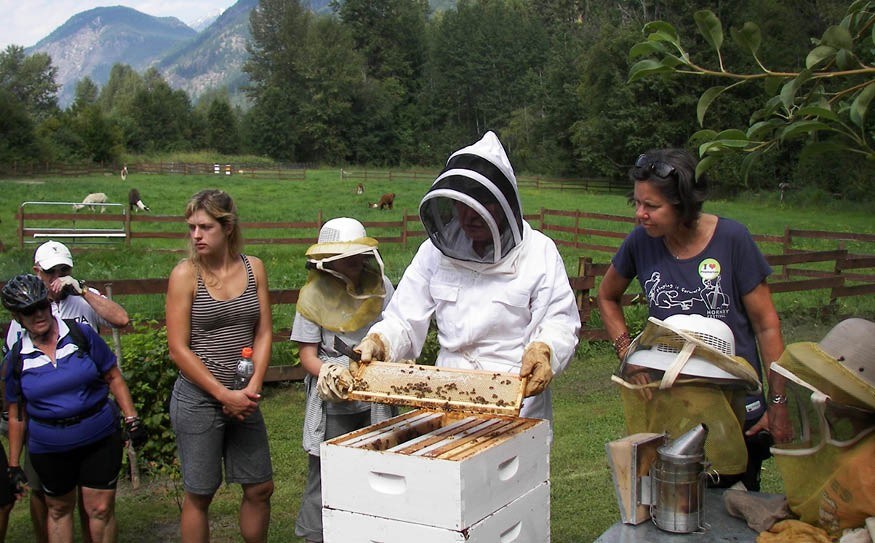These are tough times for the bee population across North America and around the world. Those who keep track of honeybees are reporting all across this continent that hives are collapsing at a startling rate.
Here in the Sea to Sky corridor, beekeeper Delores Los isn't experiencing the same issues, thankfully. The Pemberton beekeeper and honey producer said her four beehives are relatively isolated near the end of the Pemberton Meadows Road alongside the Lillooet River where wildflowers are abundant.
The isolated location of the hives means the bees aren't prone to pesticide exposure. Los said in an interview from her home just off the Hurley River Road, a popular stop at the top end of the annual Slow Food Cycle Sunday, that she believes there's very little pesticide use in the five and a half kilometre radius around her hives.
While the bees of the upper Pemberton Valley are doing well, author and freelance science reporter Elizabeth Grossman wrote in an article published by the Yale School of Forestry and Environmental Studies in April that the decline in bee populations around the world currently isn't sustainable.
Experts have dubbed this worldwide phenomenon "colony collapse disorder" and nobody really knows what is causing bee population declines of up to 50 per cent in some areas of North America.
According to Grossman, the European Commission (EC) has imposed a two-year ban on a class of pesticides known as neonicotinoids. Many researchers believe neonicotinoids have played a role in bringing down bee populations. The European Food Safety Agency has concluded the pesticides represented a high acute risk to honeybees and other pollinators.
Here in Canada, the David Suzuki Foundation is also concerned about pesticide use and its impact on pollinators. According to the foundation, the rusty-tinged bumblebee and the yellow-banded bumblebee, two native bee populations, are known to be declining in Canada.
Grossman noted that neonicotinoids aren't alone on the suspect list. She pointed to fungicides, viral pathogens and parasitic mites as other known bee killers. According to Grossman, mites and diseases have been around for a long time and no single pathogen or parasite appears to have spread significantly enough to account for the dramatic bee decline in the last few years.
Grossman reported that unprecedented levels of agricultural pesticides — some at toxic levels — in honeybee colonies prompted experts to look more closely at the connection between neonicotinoids and bee declines.
While pesticides aren't a concern for Los, mites certainly are. She said that when she first started caring for bees in 1977 that wasn't the case. Now the hives kept by Los are given a dose of formic acid to fend off the mites.
"Formic acid is something bees produce," said Los.
She uses a technique she learned from her beekeeping mentor, Phil Ellis of Squamish. Los explained that she puts holes in plastic bags, soaks newspaper in formic acid then places the newspaper inside the plastic bags and lays them on the beehive frames.
"The bees really breathe in a lot of that. It deals with the trachea mites, which are in their lungs," she said. "It's all natural to them."
This formic acid treatment is done in the fall and then again in the spring before honey production begins again.
Ellis reported that his hives did well over the winter and he is staying informed of the struggles bees are currently having.
"We try to keep our hives as clean as possible," said Ellis from his home in the Garibaldi Estates area of Squamish.
There's only so much he can do because Ellis noted that any drone is welcome at a hive so if an infected drone arrives, that drone will share any illness it might be carrying.
"We can't stop the drones from coming in," said Ellis.
He said it's very confusing for beekeepers because nobody really knows what to do about colony collapse disorder. Ellis said he has used medicine in the past but it doesn't always work. He also said he can look at a hive and find it healthy based on what he sees then return to the hive a week later, discover it has declined significantly and a short time later the hive has completely collapsed with no clear indication of what happened.
The bees Ellis keeps are currently collecting nectar from raspberry vines and pollinating the plants, which will soon start producing berries.
"Right at this particular time my bees have made it through (the winter) and so far they're happy campers," Ellis said.
While Ellis and Los are currently reporting their own hives are doing well the alarm bells are ringing elsewhere. The Suzuki Foundation has suggested that everyone can help the international bee population by planting pollinator-friendly gardens featuring native flowering plants. The foundation also discourages the use of pesticides.




